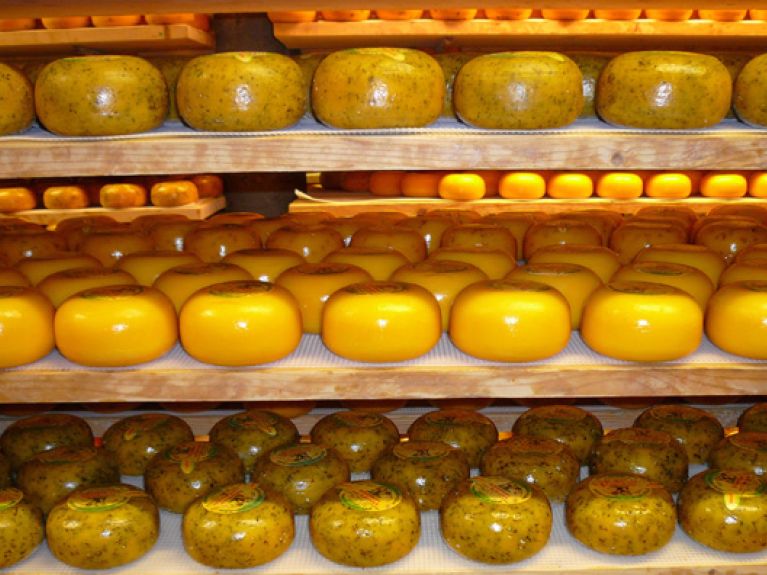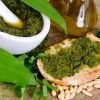Along the Cheese Route
In Germany, better cheeses do not come to the customer, the customer has to go to the cheese – on the Cheese Route, for example.

Is it possible to think of cheese and not think of France and those great monuments to cheese culture: Chaource, Brillat-Savarin, Camembert de Normandie, Livarot, Brie de Meaux and Comté? To say nothing of the associated landscapes, such as the French Jura in the east on the border to Switzerland, where a whole region would seem to have devoted itself, alongside wine, above all to cheese production. Indeed, where else in Europe do the farmers of a whole region work together, cooperatively, to be part of the production of a few, but eminently select, specialities? In Italy, yes. And in The Netherlands and Switzerland too. Perhaps also in Spain.
And in Germany? Well, things are different in Germany. There is not even one cheese here that might be regarded as a national cultural asset. There could have been one, Tilsiter, for example. It was created in the 18th century and, as the essence of a maritime cheese, might have had potential, but in the absence of strong trademark protection, it became degraded in the 20th century to the status of an industrially produced commodity. Unlike in France, there are no cheeses in Germany that have been developed and refined over the centuries, no recipes that have been handed down over generations and defended against all opposition and interference from the large cheese companies. No German cheese has become a trademark, easily found both at home and abroad.
However, a turnabout is now taking place on the German cheese scene. The change is being made by numerous small organic cheese-makers who have emerged over the past two decades. These have had the courage to make more raw milk cheeses and allow them to mature over longer periods, with sometimes outstanding results. These small producers, however, work more or less as direct marketers, with the result that even the finest products have a very limited range of distribution. In Germany, such cheeses do not come to the customer, the customer has to go to the cheese. To Schleswig-Holstein, for example. But it’s certainly worth the journey. The Schleswig-Holstein Cheese Route was launched in 1998. “Hardly anyone knew about the many delights being made here in the North,” explains Detlef Möllgaard, one of the initiators, who subsequently set up Meierhof Möllgaard, a dairy farm in Hohenlockstedt, where he brings together the region’s treasures and offers them for sale. Today roughly 30 artisanal cheese-making dairies are strung along the Cheese Route. “Most of them were set up in the 1990s,” Möllgaard adds. And the conditions were good, given the amount of land available and the dearth of people. Ideal locations can be found in the Geest region that stretches between the Danish border and Hamburg offering woodland, heaths and expanses of grassland with embankments. Hedgerows thrive there, bushes and shrubs that break the wind and prevent the sand from becoming dispersed over the pastures.
The relatively large Backensholz farm near Oster-Ohrstedt, with more than 200 cows, benefits from this, for example. One of its showcase products is the Backensholzer Deichkäse, or Dyke Cheese, the “Gold” version of which is outstanding in quality. It is a hard cheese made of raw unpasteurized cow milk which matures for between 14 and 16 months. Its aromatic taste conjures up images of summer meadows and grazing cows – a cheese with a soft finish, classy in every way.
In terms of landscape, the region around the Sorgwohld municipality is perhaps even more impressive. It is located between the Ochsenweg, an old trade route where in former times fat stock was driven to Hamburg, and the Sorgwohlder inland dunes. It is characterized by an elevated Geest landscape with alternating heaths, moors, copses, hedgerows and European spruce, and it attracts people wanting to cycle, hike and picnic — and visit the Solterbeck milk-sheep farm. “We live where other people spend their holidays,” says Ina Solterbeck, responsible for PR at the farm, which has about 150 sheep.
When grazing on the clover-green fields from late February to November, the long-legged Frisian milk sheep, some white, some black, and some black-and-white, round out the lively image of this landscape. And they complete the Schleswig-Holstein cheese-board: the young organic Shepherd’s Cheese, for example, which matures for at least eight weeks, or the old Shepherd’s Cheese, which only goes to market after a maturing period of twelve months. “It tastes a bit like a peccorino,” says Ina Solterbeck. What is particularly attractive about this product is the fine salty aftertaste. “All these cheeses have an aftertaste,” says Möllgaard, thus making an obvious link to the world of wine-tasting. And that is how these small works of art from the North should be treated, as valuable foodstuffs, and not just as something to put on your bread. “It is unlikely, however, that a real standard-bearer representing the region, like Camembert represents Normandy, will be produced here in the near future,” Möllgaard opines sceptically. “But we have already surpassed the Allgäu region, as regards the variety of the specialities available between the North Sea and the Baltic, be that Holstein alpine-style cheese, Ostenfelder organic Tilsiter or goat’s milk camembert.”
And that is really saying something, given that the Allgäu, in the deep south of Germany, is still considered the country’s great standard bearer when it comes to top-class German cheeses. This has to do, among other things, with the fact that Allgäuer Bergkäse, or mountain cheese from the Allgäu region, is one of the few German dairy products with a protected designation of origin. Furthermore, in Allgäu it is now de rigueur to allow top-quality products to mature for a really long time; the standard is almost 24 months for a mountain cheese from the Steibis dairy in Oberstaufen. To a certain extent, this comes close to French conditions.
Something is happening here in Germany, and not just in the North and South, but throughout the whole country. Perhaps Germany has become a cheese nation on the quiet. And perhaps a particular feature of the local products is that you have to go in search of these treasures. Knowing full well that they exist. ▪

